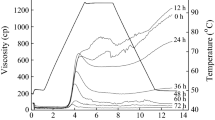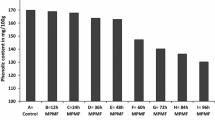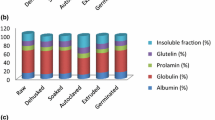Abstract
The effect of germination on the nutritive value of mung beans (Vigna radiata) was studied in raw and cooked samples after 0, 2 and 4 days of germination. Water content increased, but crude protein, lipids, crude fiber, ash and carbohydrates decreased with germination. Trypsin inhibitor activity did not change significantly while hemagglutinins were absent. Essential amino acids (methionine, tyrptophan and lysine) decreased with germination.
Net protein ratio (NPR) and protein efficiency ratio (PER) in rats decreased with germination especially in cooked sprouts. True digestibility did not change consistently due to germination or cooking. In conclusion, loss of protein quality in mung beans occurs upon germination and cooking.
Similar content being viewed by others
References
Official Methods of Analysis. Association of Official Agricultural Chemists. 11th Ed. (1970). The Association. Washington, D.C.
Borchers R and Ackerson CW (1950) The nutritive value of legume seeds. X. Effect of autoclaving and the trypsin inhibitors test for 17 species. J Nutr 41: 339–345
Bressani R and Elías LG (1977) The problem of legume protein digestibility. In: Nutritional standards and methods of evaluation of food legume breeders. pp 61–72 IDRC-TS7e
Carpenter KJ (1960) The estimation of the available lysine in animal protein foods. Biochem J 77: 604–610
Chattopadhyay H and Banarjee S (1953) Effect of germination on the biological value of protein and the trypsin inhibitor activity of some common Indian pulses. Ind J Med Res 41: 185–189
Chen LH Wells CE and Fordham JR (1975) Germinated seeds for human consumption. J Food Sci 40: 1290–1294
Conkerton EJ and Frampton VL (1959) Reaction of gossypol with free amino groups of lysine in proteins. Arch Biochem Biophys 81: 130–131
Eggum BO and Campbell LD (1978) Nutritional and antinutritional assay. IAEA publication, Vienna 1979
Elías LG Colindres R and Bressani R (1964) The nutritive value of eight varieties of cowpea (Vigna sinensis). J Food Sci 29: 118–122
Elías LG Muñoz CA and Bressani R (1973) Effect of germination and maturation on the nutritative value of common beans (Phaseolus vulgaris). In: Nutritional aspects of common beans and other legume foods. Ed Jaffé WG Caracas. Venezuela. Proceedings of a meeting held in Riberão Preto, November 1973 pp 139–152
Elías LG Fernández DG de and Bressani R (1979) Possible effects of seed coat polyphenolics on the nutritional quality of bean protein. J Food Sci 44: 524–527
Evans RJ and Bauer DH (1978) Studies of the poor utilization by the rat of methionine and cystine in heated dry been seed (Phaseolus vulgaris). J Agric Food Chem 26: 779–784
Everson GJ Steenbock AC Cederquist DC and Parsons HT (1944) The effect of germination, the stage of maturity and the variety upon the nutritive value of soybean protein. J Nutr 27: 225–229
Fordham JR Wells CE and Chen LH (1975) Sprouting of seeds and nutrient composition of seeds and sprouts. J Food Sci 40: 552–556
Honavar PM Shih CV and Liener IE (1962) Inhibition of the growth of rats by purified hemagglutinin fractions isolated from Phaseolus vulgaris. J Nutr 77: 109–114
Jaya TV Krishnamurthy KS and Venkataraman LV (1975) Effect of germination and cooking on the protein efficiency ratio of some legumes. Nutr Rep Internat 12: 175–183
Kakade ML Simons N and Liner IE (1969) An evaluation of natural vs synthetic substrates for measuring the antitryptic activity of soyabean samples. Cereal Chem 46: 518–526
Liener IE and Kakade ML (1969) Protease inhibitors. In IE Liener ed Toxic constituents of plant foods. Academic Press, New York
Liener IE (1977) Biochemical aspects of New Protein Food, FEBS Letters 44: 129
Price ML Van Scoyoc S and Butler LG (1978) A critical evaluation of the vanillin reaction as an assay for tannin in sorghum grain. J Agric Food Chem 26: 1214–1218
Tkachuk R (1977) Calculation of the Nitrogen-to-protein conversion factor. In: Nutritional Standards and Methods of Evaluation for Food Legume Breeders 78–82 IDRC-TS7e Ottawa
Venkataraman LV Jaya TV and Krishnamurthy KS (1976) Effect of germination on the biological value, digestibility coefficient and net protein utilization of some legume proteins. Nutr Rep Internat 13: 197–205
Ward AT Marquardt and RR Campbell LD (1977) Further studies on the isolation of the thermolabile growth inhibitor from the faba bean (Vicia faba L. var. minor). J Nutr 107: 1325–1334
Author information
Authors and Affiliations
Additional information
Publication INCAP/UNU-4.
Rights and permissions
About this article
Cite this article
Noor, M.I., Bressani, R. & Elias, L.G. Changes in chemical and selected biochemical components, protein quality, and digestibility of mung bean (Vigna radiata) during gemination and cooking. Plant Food Hum Nutr 30, 135–144 (1980). https://doi.org/10.1007/BF01099051
Issue Date:
DOI: https://doi.org/10.1007/BF01099051




